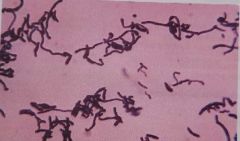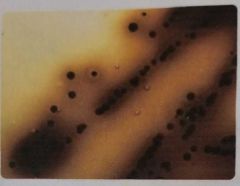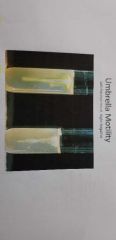![]()
![]()
![]()
Use LEFT and RIGHT arrow keys to navigate between flashcards;
Use UP and DOWN arrow keys to flip the card;
H to show hint;
A reads text to speech;
12 Cards in this Set
- Front
- Back
- 3rd side (hint)

Corynebacterium spp. Characteristics |
Facultatively anaerobic, gram-positive, non-spore-forming rods, club-shaped, Chinese letters, babes-ernst granules |
|
|
|
Corynebacterium diphtheriae virulence factors |
Exotoxins: diphtheriae toxin--> lysogenized by bacteriophage with toxin gene (tox+) toxin A&B |
|
|
|
Diagnostics of corynebacterium |
Aerobic conditions at 37°C Catalase positive, non-motile, urease neg., nitrate reduction positive |
|
|

Type of agar (corynebacterium) |
Loeffler's serum agar: pleomorphism & metachromatic, Cystine-tellurite blood agar CTBA: black & gray colonies, Modified tinsdale medium: black colonies with brown halos |
|
|

Elek's test |
Immunodiffusion test: filter paper with diphtheriae antitoxin added to plate, look for specific precipitin lines |
|
|
|
DPT |
Diphtheriae- Pertussis-Tetanus: given to children routinely as part of immunization regimen |
|
|

Listeria monocytogenes characteristics |
Coccobacillus appears like cocci, gram-positive, nonsporulating forming rods |
|
|
|
Listeria monocytogenes virulence factors |
Hemolysin: listeriolysin O, Catalase, surface protein p60, phospholipase C, and superoxide dismutase |
|
|
|
L. monocytogenes diagnostic |
SBA, chocolate agar, prefers slightly increased CO2, colonies: narrow zone of hemolysis, small round, smooth and translucent. Optimal growth: 30°- 35°C |
|
|
|
Identifying L. monocytogenes |
Catalase positive, motility: "umbrella", CAMP test: block type hemolysis, Hippurate hydrolysis positive, Bile Esculin positive |

|
|
|
Erysipelothrix rhusiopahie |
Thin, Gram-positive, non-spore-forming, pleomorphic rods |
|
|
|
Diagnostics of E. Rhusioparhiae |
Culture: CO2 needed, Blood agar or chocolate agar: colonies are grey or translucent, alpha hemolysis. *production of hydrogen sulfide on triple sugar iron |
|

